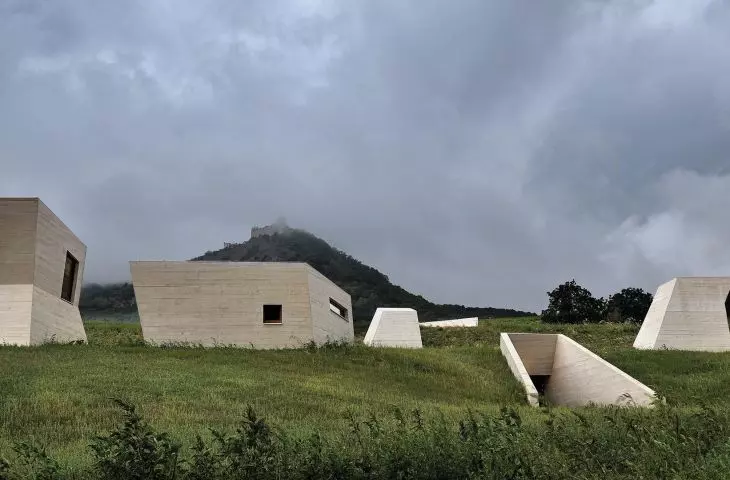Article from A&B issue 04|2023
Pavlov and Dolní Věstonice, located in the southern part of Czech Moravia, at the foot of the Pavlov Hills, are highly regarded archaeological sites in Europe and the world. These areas have been inhabited by humans since at least the Paleolithic period, as proven by the aforementioned sites. The age of the oldest discovered mammoth hunting camps has been estimated at twenty-eight thousand years.
conceptual sketch by the authors of the architectural project
© Architektonická kancelář Radko Květ
The most famous local find, the Venus of Věstonice, discovered in 1925, is similarly dated. It's a tiny figurine of a naked woman, which is believed to be the oldest ceramic art object ever discovered in the world (along with animal likenesses found nearby). The object is in the collection of the Museum of the Moravian Region in Brno, but due to its protection and priceless value, it is very rarely opened to the public.
location plan
© Architektonická kancelář Radko Květ
Such a unique place requires an equally unique architectural setting. In 2002, the idea of creating an exposition nearby came up, which would bring the history of the area closer to the public and present finds from a local archaeological site that had been in operation for almost a century. The finds are mainly skeletons and everyday objects. The main raw material used for tools was moraine flint, while ornaments and jewelry were made from bones, but not only. Another interesting discovery is a mammoth blow with engravings that have been interpreted as a topographical map of the area, as well as a wolf's radial bone with regular incisions, which researchers describe as an instrument indicating attempts at counting or measuring.
A night shot of the building's entrance, which leads from the outside directly into a lobby built into the grounds; in the background on the right, the Věstonice Reservoir can be seen
Gabriel Dvorak | © Architektonická kancelář Radko Květ
The archaeopark was built on the site of the Pavlov open archaeological site (classified as part of the circle of Gravetic cultures, dated to between 26,000 and 24,000 years ago) and took its name. The author of the architectural design is the Czech firm Architektonická kancelář Radko Květ. It was Radko Květ and Pavel Pijáček who headed the design team responsible for the building's concept. It was created in close cooperation with the originators of the project, namely, among others, the Institute of Archaeology of the CAS in Brno, which was both a sponsor of the project and an expert partner. The Mikulov Regional Museum was also involved in the project. The conceptual design began to emerge in 2010, and implementation took off four years later. In 2016, the Pavlov Archeopark was visited by its first visitors.
The geometric buildings contrast with the green, slightly undulating terrain; up close, the reflections of the formwork on the raw concrete facade are visible
Gabriel Dvorak | © Architektonická kancelář Radko Květ
It was to be expected that surprises and unforeseeable difficulties would await the contractors at such a site. During archaeological excavations preceding construction at the site where the architecture was planned, a pit filled with mammoth bones was revealed. It was decided that the original design should be modified, and that the discovered site should be preserved and exposed, since the find is a significant national cultural monument. The in situ exhibit was therefore integrated between the buildings and landscaping elements. The term in situ describes monuments that remain where they were discovered. According to the architects, the site was covered with a layer of sand for the duration of construction and protected with a temporary structure made of wood, which was eventually replaced with retaining walls and a foundation system. During the construction of the Archeopark, any interference in areas where archaeological research could potentially be conducted in the future was prohibited. The construction site was therefore strictly limited to the area already surveyed. Archaeological excavations were assumed to be about five meters below the site found.
Excavations at the Pavlov archaeological site
Gabriel Dvorak | © Architektonická kancelář Radko Květ
The difficulties faced by the architects did not end there. The solutions had to take into account not only the very specific site conditions and terrain, but also the scenic qualities. The area around the village of Dolní Věstonice is dotted with beautiful Moravian vineyards and limestone spurs, as well as castle ruins. As a result, the site was also included in the landscape protection. Nearby is the Věstonice Reservoir, a reservoir on the Dyja River in South Moravia, which was built on the site of the village of Mušov.
The concrete towers protruding above the surface of the terrain are meant to be a reference to the limestone spurs emerging now and then in the surrounding fields and vineyards—a characteristic sight in this part of the Czech Republic; in the background, on the lower peak of the Děvín massif, you can see the permanent ruins of the Gothic Děvičky Castle
Gabriel Dvorak | © Architektonická kancelář Radko Květ
Since 1994, along with the estuary of the Iglava and Svratka rivers, it has been a nature reserve. Above the reservoir rises Děvín, the highest peak of the micro-region of Pavlovské vrchy (Pavlov Hills) partially included in the Pálava Landscape Park (Chráněná krajinná oblast Pálava). On the lower peak of the Děvín massif are the aforementioned charming ruins of the Gothic Děvičky Castle. A local tourist attraction is the only cave in the Hills open to the public—Na Turoldu, and nearby, on the top of Svatý kopeček, is located a complex of chapels—a pilgrimage destination. As you can see, there is something for both Moravian wine lovers and history and religious people. The archaeopark is an addition to the tourist infrastructure of the region and a place where you can spend time in an interesting way, especially when the weather does not allow you to visit the open-air attractions.
The entrance to the building leading visitors from outside directly to the underground entrance hall and changing rooms—intended by the architects as a reference to the cave, another element characteristic of the area
Gabriel Dvorak | © Architektonická kancelář Radko Květ
Landscape architect Waclaw Babka assisted a team of architects from Architektonická kancelář on this project. Together, architectural solutions and landscaping were thought out, taking into account the unique location. Any interference in the development of the village had to be approved by the relevant authority and representatives of the municipality and be in accordance with the zoning plan. Local authorities and representatives of the protected area positively evaluated the architects' idea of hiding most of the architecture under the surface of the land and thus respecting the view axes. According to the architects, cooperation with the various institutions went well.
inside the building looks as austere as outside, only wood appears on the floor, which slightly warms the rooms with concrete walls and ceilings;—natural and artificial lighting falling on the curves of the walls and ceilings give an interesting chiaroscuro effect
Gabriel Dvorak | © Architektonická kancelář Radko Květ
Projecting above the ground surface, the concrete towers, which serve primarily as skylights, are a spatial reference to the limestone rocks protruding in the surrounding meadow and vineyard areas. The underground part is meant to evoke a cave. The museum is a reinforced monolithic concrete building. It was possible to maneuver the walls and towers in such a way that the curves of the ceiling do not need additional massive supports disfiguring the open exhibition space. The complexity of shapes and directions is impressive and makes for a very interesting play of light. By this I mean both the introduction of natural light into the underground and the operation of artificial light. The architects paid a lot of attention to physical models at the conceptual design stage. Various options were analyzed on mock-ups. At the implementation stage of the project, after making changes due to the surprises found, the light factor was again analyzed and shapes reflecting the cardboard model were developed structurally.
In such an ascetic interior, illuminated display cases with exhibits catch the eye
Gabriel Dvorak | © Architektonická kancelář Radko Květ
The architects managed to achieve the intended effect of being in a grotto. The entrance area is clearly marked and distinguished by an interesting yet discreet form. Thanks to its slope, it can also be used as a small stage or backdrop for some outdoor activity. The entrance leading from the outside directly into the underground part overgrown with vegetation also resembles a descent into a cavern. This further emphasizes the economy of means and materials. Aside from concrete with visible traces of formwork, oak wood covering the interior floor and glass in places, there is absolutely nothing here. All the visitor's attention is focused outside on the surrounding landscape, while inside it is solely on the exhibition. The exceptions are where openings in the towers frame the view of characteristic landscape elements.
In such an ascetic interior, illuminated display cases with exhibits catch the eye
Gabriel Dvorak | © Architektonická kancelář Radko Květ
The exhibition strikes a balance between the traditional way of presenting museum exhibits and contemporary audiovisual methods. Authentic finds from the area are shown here, along with the entire process that explains how they got here. Here, that is, behind the glass of a museum display case. Through photographs and documents, visitors can learn about the history and process of the various excavations. Visitors also get a chance to learn about the way ancient man functioned, especially aspects such as beliefs, burial rituals, hunting and daily life.
projection
© Architektonická kancelář Radko Květ
The main exhibition space is more than five hundred square meters, and with the archaeological facilities and administrative, social and technical areas—almost a thousand. The author's description reads: "The site reminds us of a bygone historical era and is both part of the universal cultural heritage and a symbolic integral part of local culture, shaping the local community's connection to the region. It embodies the cultural values of which the local people are proud and which define their attitude to the country."
cross-section
© Architektonická kancelář Radko Květ
The project was arguably challenging in many ways. The architects had to respect not only the landscape context and everything that influences it, but also what is beneath the surface of the site. In addition, the project's designers, constructors and contractors had to be very flexible and respond on an ongoing basis to implementation difficulties encountered. This is almost as much an architectural project as it is an outdoor establishment. The realization of the site required cooperation and agreement with many entities, including local authorities—and this is not always easy, if only because of different points of view and diverging interests. The Pavlov Archeopark proves that it can be done, and is an interesting addition to the tourist offer of the region, and with its form it does not come to the fore, but subtly fits into the picturesque scenery.
cross sections
© Architektonická kancelář Radko Květ
Marta KULAWIK
drone photography: Ales Jungmann
other photos: Gabriel Dvorak
© Architektonická kancelář Radko Květ


























































